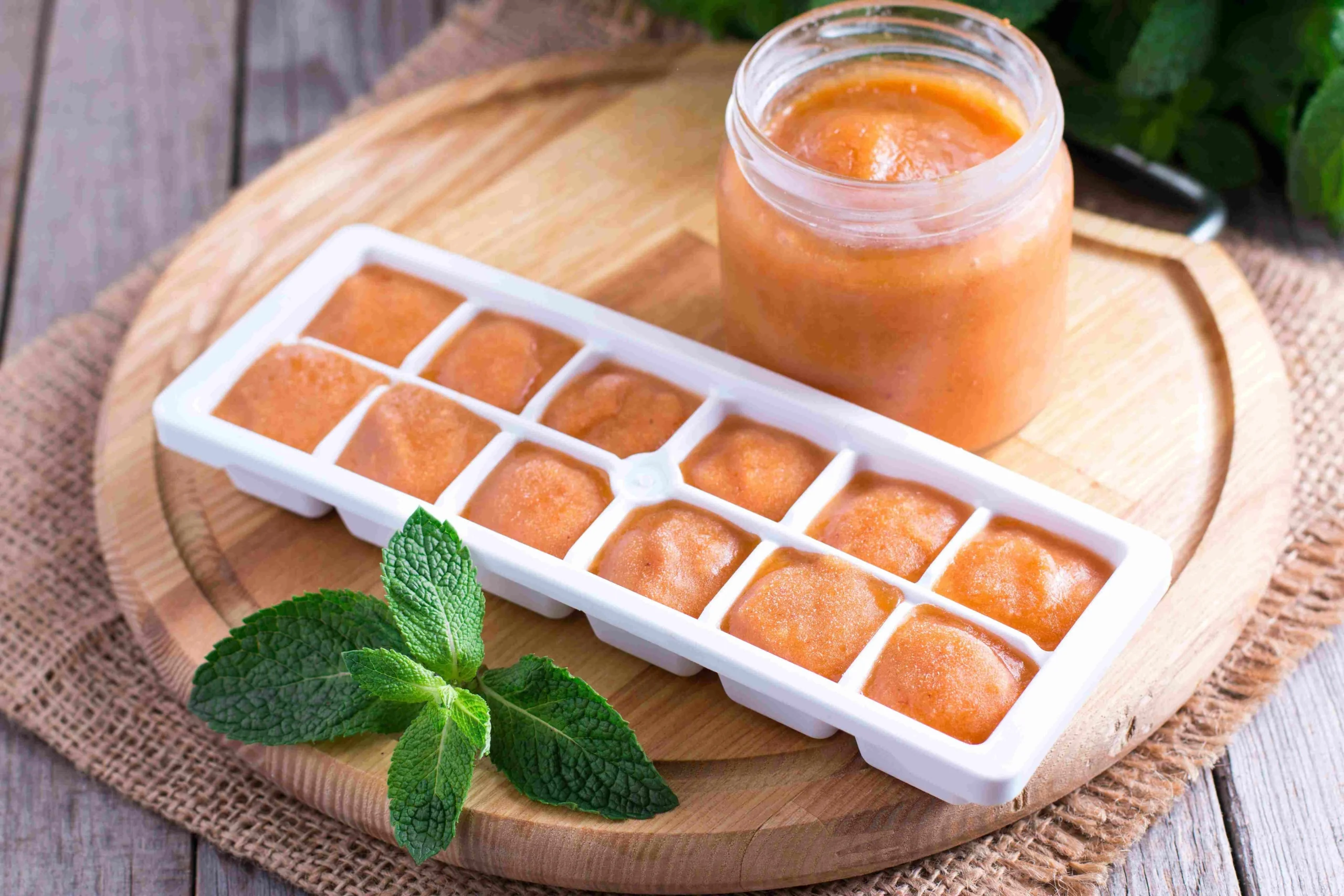The benefits of frozen baby food – plus homemade recipes to try
Reading time:
Reading time:

Author: Jessica D’Argenio Waller, MS, CNS, LDN
Once your little one is ready to start solids, a whole new world opens up—for both of you. Suddenly, you’re embarking on a journey of exploring flavors and textures together—and all the prep, trial and error that comes with it. One way to make the process easier? Frozen baby food. Marrying both convenience and nutrition, frozen baby food is a smart way to simplify meal preparation while preserving essential nutrients, ensuring that your baby has all they need to thrive, with way less stress for you. Because of the satisfaction of being able to pull out a premade puree from the freezer before the baby’s next mealtime? Priceless.
In this guide, we’ll highlight the benefits of frozen baby food, the best way to make and store frozen baby food, what to look for in the store, and recipes to try at home.
Frozen baby food is baby food that has been prepared and frozen for future use, then thawed in individual portions before serving to your little one. By freezing the food, you can ensure the nutrient quality remains high while setting yourself up for convenience later on.
There are several methods for making frozen baby food at home, including pureeing fresh fruits and vegetables, cooking and mashing them before freezing, or even freezing homemade baby food in ice cube trays for easy portioning.
In stores, you can find frozen baby food specifically tailored for different developmental stages. These may include a range of single-ingredient purees, such as Little Bellies Organic Mango Puree Cubes, suitable for babies who are just starting their solid foods journey; and multi-ingredient blends, such as Little Bellies Organic Sweet Potato, Carrot & Brown Rice Puree Cubes, suitable for older babies who are ready to explore a wider range of flavors and textures.
When you’re just beginning to introduce solid food to your little one, (typically between ages 4 to 6 months) purees made from single ingredients such as apples, pears, sweet potatoes, and carrots offer essential nutrients and can help familiarize your baby to new flavors in a smooth and palatable form.
Beyond 6 months, some babies may be ready to explore combination blends, like apple and spinach or sweet potato and chicken, and chunkier textures that can help develop their oral motor skills as they learn to chew and swallow more complex foods.
Should you opt for frozen baby food over refrigerated or shelf-stable options? Let’s take a look at the benefits and considerations of each choice but know that they can all be part of the full picture when it comes to your baby’s meals—you can rotate amongst all three categories.
Making your own frozen baby food at home can be a big timesaver. Here’s how to get started.
Our best advice? Be sure to choose fruit that will generally retain its texture after freezing.
Single fruit purees to try:
To make a single fruit puree:
Combine 2 cups of fresh, frozen or cooked fruit of choice and add to a blender.
Blend until smooth, adding a little water if needed to achieve the desired consistency.
Pour the puree into ice cube trays, silicone freezer trays or freezer-safe glass storage jars, leaving enough room for expansion.
Place the trays or jars in the freezer and freeze until solid.
Once frozen, transfer the puree cubes to a freezer-safe container or bag for storage.
Thaw individual cubes as needed and serve to your baby as a nutrient-dense snack or meal.
Fruit blend purees to try:
To make a fruit blend puree:
Single vegetable purees to try:
To make a single vegetable puree:
Vegetable blend purees to try:
To make a vegetable blend puree:
Veggie and fruit puree blends to try:
To make a veggie-fruit blend puree:
Check out our best fruit and veggie guides for every age and stage.
Storing frozen baby food properly ensures its safety for your little one. The most important tip to remember is that once frozen, baby food should remain frozen until you’re ready to thaw out a portion and serve. Here are some tips on how to store frozen baby food and efficiently thaw it out before those hungry cries start.
Frozen baby food can be an ideal home remedy for teething, as it makes a great natural baby teether to soothe those sore gums. Cold or frozen food can help ease teething aches and pain in your little one, providing a slight numbing effect.
Do note that frozen teethers may be too cold straight from the freezer, so before offering them to your infant, let them sit out for 2 to 3 minutes to warm up a bit first.
It’s easy to make frozen baby food teether pops and bites using Little Bellies Organic Mango Puree Cubes for babies who have already started solids. We recommend two methods:
Mesh teethers: The slightly thawed frozen cubes can be added to a silicone mesh strainer and offered to your baby to mouth on. As the cubes melt further, they’ll make a soothing treat.
Popsicle bites: Thaw ½ cup of puree cubes, then blend with 2 tablespoons of breast milk or unsweetened dairy-free yogurt. Spoon or pour the mixture into your freezing molds (we like small popsicle molds or silicone ice trays), filling about ¾ full. Freeze until solid, about 3 hours, then let sit at room temperature for 1-3 minutes before offering to your baby to enjoy.
You should be able to find frozen baby food at local stores such as Target and Whole Foods Market, in addition to your local health food store. Be sure to check the freezer aisle for the organic and natural products section or look for a freezer case or shelves designated for frozen baby food. Both Target and Walmart offer convenient online ordering (ideal for busy parents!), which means you can quickly add it to your cart and pick it up at the store or have it delivered to your doorstep. When shopping for frozen baby food, be sure to check product labels for information on ingredients that fit your little one’s dietary needs, scan the nutritional content, and confirm that it’s age-appropriate for your baby.
Whether you batch-prepare frozen baby food at home or pick up store-bought frozen baby food at your nearest store, frozen baby food can be a nutrient-rich and convenient choice for your baby’s snack and mealtimes—and one that saves you time in the long run. It’s a versatile and cost-effective choice that reduces waste and satisfies your little one’s taste buds—while also playing a key part in their journey to solid foods.

Get the latest news on parenting tips, food play hacks, promotions and giveaways!
Subscribe Now